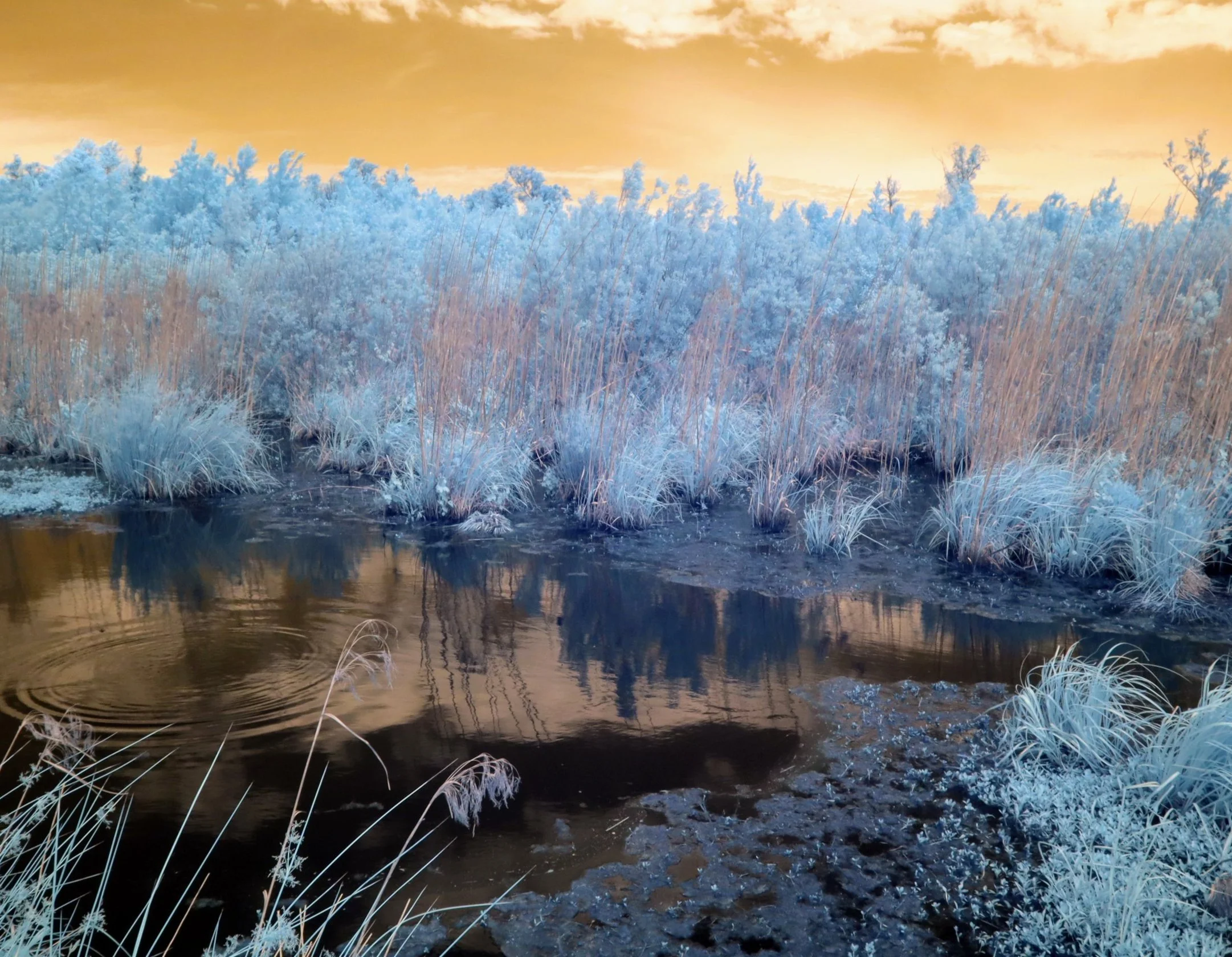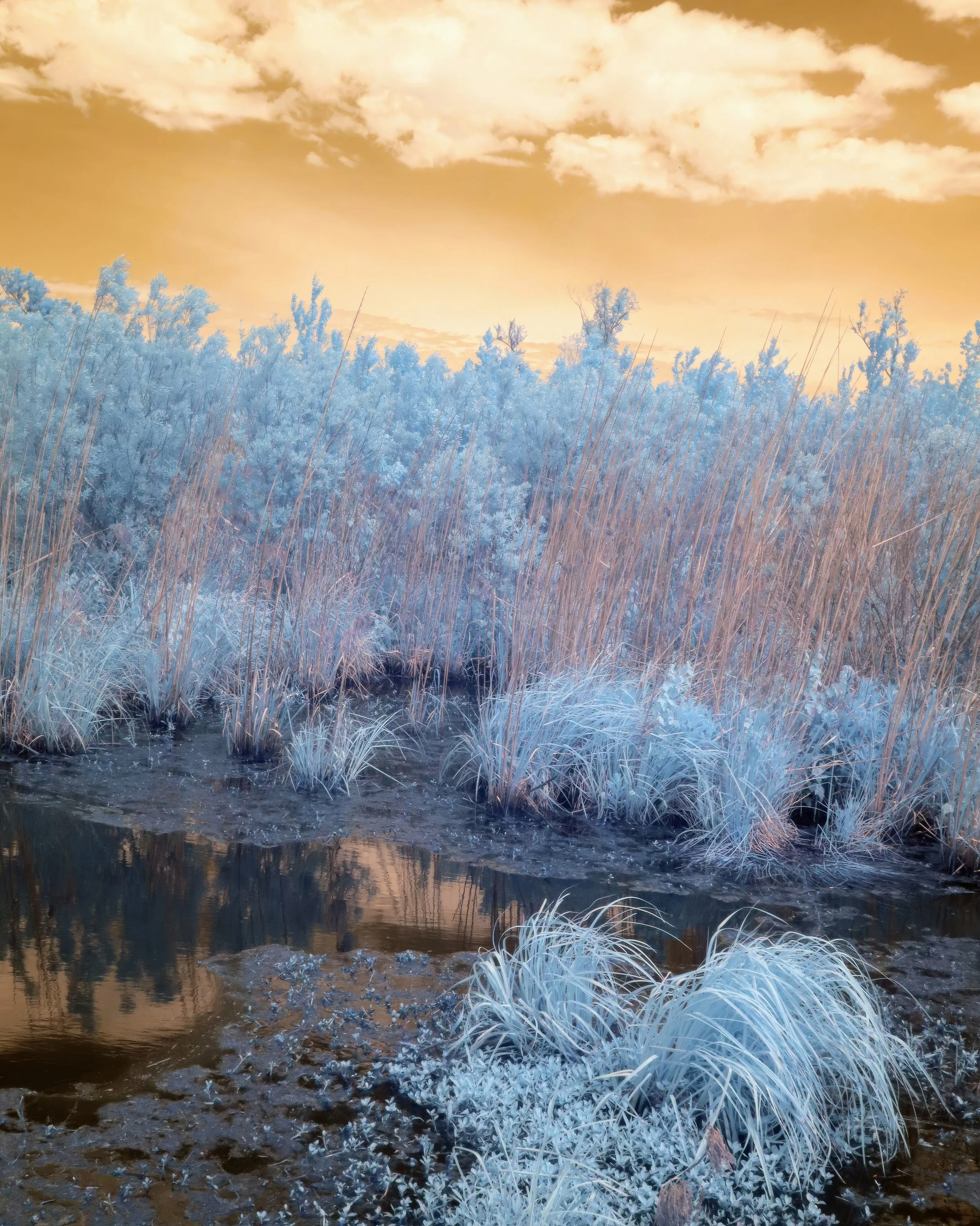A conversation with Lita Tirak, Ph.D.
At the intersection of historical research, scientific inquiry, and visual storytelling, the photographic work of Lita Tirak, Ph.D., offers a compelling lens through which to reimagine overlooked landscapes and legacies. Her series on the Great Dismal Swamp—currently on view at the Linda Matney Gallery—merges color infrared photography with decades of academic and curatorial research into the electromagnetic spectrum. The result is a body of work that both reframes perception and honors the layered histories embedded in the land.
Tirak’s images challenge the long-standing narratives that have cast the Swamp as inhospitable terrain, revealing instead a sacred geography shaped by Black and Indigenous resilience, ingenuity, and autonomy. Through thoughtful technique and ethical collaboration, her work invites viewers—especially those engaged in cultural stewardship—to consider how photography can not only render the invisible visible, but also serve as a form of reparative vision.
In the conversation that follows, Tirak reflects on her methods, motivations, and the responsibility of artists who engage with histories that are not their own. Her approach exemplifies how contemporary photography can support museum-worthy inquiry—where aesthetics, ethics, and advocacy are intimately linked.
Lita Tirak, Washington Ditch I, Great Dismal Swamp. Photograph
Can you tell me who you are and your photographic interests?
My name is Lita Tirak and I live in Williamsburg, Virginia. My ideas are applied through the camera, and the works that are on display at the Linda Matney Gallery synthesize methods and insights from decades of research.
At the core of my academic, photographic, and curatorial research, I explore the limits of human vision—and the tools that help us see beyond those boundaries. The electromagnetic spectrum (EMS) has been a technical interest from my doctoral dissertation on X-rays, to my current artistic exploration with color infrared. The art of the EMS can interrogate reality, revealing signatures of unexpected texture and false color that challenge our perceptions of the visible world.
How did you come to explore the Great Dismal Swamp as subject matter?
For the series on the Great Dismal Swamp, I chose color infrared because it can confront our own assumptions about what is “dismal.” The colors are deliberate references to African colors of spirituality and wealth: blue, gold, and white. Rather than depict a hostile, mosquito-ridden wilderness, the images invite viewers to see the swamp as a private sacred space—where freedom-seekers once used their skills and survival to create lives more industrious than what was possible beyond borders.
Lita Tirak, Washington Ditch I, Great Dismal Swamp. Photograph
Land surveyor, William Byrd II, gave the swamp its name because he thought it was so miserable it was perceived as uninhabitable for man or animal. Yet, the Great Dismal Swamp stretching from Suffolk and Chesapeake Virginia, into northeastern North Carolina, was a place where freedom seekers built a civilization deep within the marshes and cypress trees to avoid the eyes of oppressors and the system of slavery.
I’ve been drawn to this place not only for its natural and historical richness but because it represents a powerful legacy of Black and American Indigenous resistance, entrepreneurship, and knowledge exchange. The Swamp was a confluence of trading goods and knowledge sharing with the American Indigenous, freed people, as well as the people who were enslaved under contract by George Washington to build the 22 mile long Dismal Swamp Canal—which is the oldest operating man-made canal in the country. Unsurprisingly, the Great Dismal Swamp was a stop on the Underground Railroad.
I have photographed the Swamp in every season of the year with color infrared, to understand how the tones, landscape, and conditions change. Spring and autumn offer the best landscapes for capturing lush foliage that reflects the heat of the sun. In winter, photographs have an icy look, where the infrared detects frozen chlorophyll and reacts to it without the reflection of heat.
As an artist, what is your goal with this work?
I am not a person of color, nor do I have ancestral ties to the Swamp. My goals are twofold: first, to collaborate with communities directly connected to the Swamp to deepen this photographic series and honor their stories; and second, to ensure that any financial proceeds from the work are directed to charities or enterprises linked to the Swamp and its people. This project is not motivated by personal profit.
At this moment in history—both nationally and globally—it’s more important than ever to listen to and learn from people outside our usual circles. These photographs are one way to begin that process. The sacredness of the Swamp isn’t only in its past, but in its living legacy. Your neighbor may be descended from those who survived and thrived there. Have you reached out to hear their story?
The camera can take us into hidden landscapes—but it’s only through collaboration and connection that we can truly see.
Lita Tirak, Winter at the Railroad Ditch II, Great Dismal Swamp. Photograph




